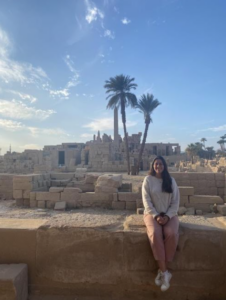
21
OctWashington D.C.: Building and Experiencing Sacred Space in the Tomb of Ankhtify
Registration is Required
Presented by: Dr. Inês Torres; Postdoctoral Research Fellow at the Centre for the Humanities (CHAM) of NOVA University Lisbon, Portugal
- 12:00 PM ETWashington, D.C.
- Zoom
- + Add to Calendar
Lecture Information
 Ankhtify was a nomarch during the First Intermediate Period. His tomb, at el-Mo’alla just south of Luxor, is well known for its autobiographic text—but that text has never been analyzed in context. Ancient people would only have read Ankhtify’s autobiography in his tomb, experiencing it within the sacred space of a funerary monument. The text was written in sections, which were divided among several columns, thus forcing readers to walk around the tomb in order to gather all the information he wished to convey. How does the spatial distribution of Ankhtify’s autobiography affect the way(s) in which one reads and interprets this text?
Ankhtify was a nomarch during the First Intermediate Period. His tomb, at el-Mo’alla just south of Luxor, is well known for its autobiographic text—but that text has never been analyzed in context. Ancient people would only have read Ankhtify’s autobiography in his tomb, experiencing it within the sacred space of a funerary monument. The text was written in sections, which were divided among several columns, thus forcing readers to walk around the tomb in order to gather all the information he wished to convey. How does the spatial distribution of Ankhtify’s autobiography affect the way(s) in which one reads and interprets this text?
Space is a social production: more than a physical area for the movement of people, it has meaning that is (re)negotiated by human interaction. As such, this lecture investigates how physical space could shape individual and collective experience, considering both the individual agency of the tomb owner in designing and building the tomb as a monument to his memory, and the importance of the experience of the tomb visitor as an agent in perpetuating the memory of the deceased. Thus, this presentation aims to understand the possible motives that led Ankhtify to disperse his autobiography throughout his tomb, and how that spatial distribution could have affected the reader.
Speaker Bio
 Dr. Inês Torres is a Postdoctoral Research Fellow at the Centre for the Humanities (CHAM) of NOVA University Lisbon, Portugal. She has a Ph.D. in Egyptology from Harvard University, an M.Phil. in Egyptology from the University of Oxford, and a B.A. in archaeology from the University of Lisbon. Her main research focuses on the analysis of the ancient Egyptian tomb as a social space, where the living interacted with each other and with the dead, analyzing how the physical space of the tomb influenced the ways in which memory was crafted and the deceased was remembered.
Dr. Inês Torres is a Postdoctoral Research Fellow at the Centre for the Humanities (CHAM) of NOVA University Lisbon, Portugal. She has a Ph.D. in Egyptology from Harvard University, an M.Phil. in Egyptology from the University of Oxford, and a B.A. in archaeology from the University of Lisbon. Her main research focuses on the analysis of the ancient Egyptian tomb as a social space, where the living interacted with each other and with the dead, analyzing how the physical space of the tomb influenced the ways in which memory was crafted and the deceased was remembered.